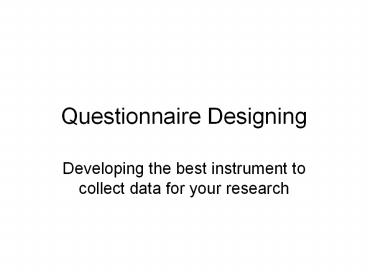Questionnaire Designing - PowerPoint PPT Presentation
1 / 20
Title:
Questionnaire Designing
Description:
Questionnaire Designing Developing the best instrument to collect data for your research Steps in research project Finalize the method of research Set schedule ... – PowerPoint PPT presentation
Number of Views:139
Avg rating:3.0/5.0
Title: Questionnaire Designing
1
Questionnaire Designing
- Developing the best instrument to collect data
for your research
2
Steps in research project
- Finalize the method of research
- Set schedule
- Determine population and sample
- Design and pre-test the questionnaire
- Training of interviewers
- Implementation of survey
- Compile and computerize data
- Data analysis and final report
3
What is a questionnaire?
- A questionnaire is an instrument that is used for
collecting information (data), which is later
analyzed and summarized to answer your research
question - A questionnaire is the most important part of the
research project. - Remember Garbage in garbage out!
4
Types of information collected
- Descriptions about the respondent and their
background (demographics) - Behaviors and habits (e.g., smoking, diet,
exercise) - Preferences or opinions
- Medical data (e.g., height, weight, FBG, blood
pressure, etc.) - Social data (e.g., grades in exams)
5
Categories of questionnaires
- By method of data collection
- Self-administered
- Interview schedules
- Data extraction forms
- By type of data to be collected
- Quantitative data (numbers, categories)
- Qualitative data (opinions, beliefs)
6
Common types of questionnaires
- Household interview schedules
- Census
- Demographic surveys
- Individual interview schedules
- KAP questionnaires
- In-depth interviews
7
Commonly used terms
- Interview and Interviewer
- Respondent (interviewee)
- Informed consent and confidentiality
- Codes, coding (answer categories)
- Other (specify)
- No answer/missing information
- Pre-testing
- Internal consistency
8
Types of questions
- Respondent identification
- Demographic information
- Pre-coded questions
- Open-ended questions
- Best-choice questions
- True/false questions
9
Biases in questionnaires
- Incomplete list of responses in a question
- Non-response bias, when a large number of
respondents say I dont know - Response bias, when respondent tries to tailor
his response to what he thinks the interviewer
wants - Wording - using leading statements
- Choices may affect the response
10
Examples objective
- What is your age? (Record age in completed years)
- What was your age on your last birthday?
- How many children do you have?
- What is your occupation? (Specify)
- How many rooms are there in your house?
- Do you own this house? (Yes/No)
11
Examples objective
- Mutually non-exclusive categories
- What is your average monthly income?
- Less than SR 10,000
- SR 10,000 to SR 20,000
- SR 20,000 to SR 30,000
- SR 30,000 or more
12
Examples objective
- Mutually exclusive categories
- What is your average monthly income?
- Less than SR 10,000
- SR 10,000 to SR 19,999
- SR 20,000 to SR 29,999
- SR 30,000 or more
13
Examples subjective
- Are you satisfied with the quality of services in
this hospital? - Yes
- No
- Dont Know/No Answer
- A majority of respondents would answer Yes to
this question. Why?
14
Examples subjective
- What is your impression about the quality of
services in this hospital? - I am fully satisfied
- I am somewhat satisfied
- I am not fully satisfied
- I am not satisfied at all
- Dont Know/No Answer
15
Sensitive questions
- Age and income questions elicit private
information - What is your age?
- What is your monthly income?
- To make them less sensitive, give a range
- What was your age on your last birthday?
- Less than 40 years
- 40 49 years
- 50 59 years
- 60 years and above
16
General tips for questions
- Questions should be short, clear, simple and
logical - Start with easy and less sensitive questions
- Gradually move to more difficult and sensitive
questions - Keep as few response categories as possible
- Always try to use pre-coded questions
17
General tips for interviews
- Greet the respondent
- Introduce yourself
- Explain the objective of the research
- Explain what questions will be asked
- Seek informed consent before starting
- Keep the interview short (max. 30 minutes)
- Thank the respondent at the end
18
Considering data entry
- Questionnaires must be designed with data entry
and analysis steps in mind - Pre-code the questions as much as possible
- Follow a certain pattern in the format of the
questionnaire (study the example questionnaire
given) - Sequencing of questions and sections
- Skip patterns
- Appropriate space to record the numbers (e.g.,
fasting blood glucose level, SBP / DBP)
19
Making an empty database
- Use SPSS, Epi-Info or other statistical software
to make an empty database of your questionnaire - As a pre-test, enter 5-10 questionnaire to
identify and rectify potential problems in data
entry.
20
Next steps in research projects
- Schedule meetings with your advisors (both
Community Medicine and other) - Develop a plan of your research project (who will
do what and when) - Design and pre-test your questionnaire
- Learn how to enter data in SPSS
- Learn how to do simple analysis in SPSS































